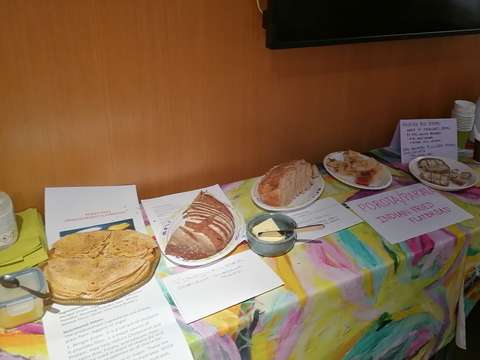Naapurin suusta: Bakers, bread and bread souvenirs from around the world at KAMU

KAMU WeeGee smelled like bread when delicacies from India's Bengal and Maharashtra, Salla, Russia and Uusimaa were laid on the table on a Friday evening in November. In addition, we heard bread memories from Kenya, Egypt, Myanmar and Eastern and Western Finland.
The KAMU WeeGee concept is being renewed, and as part of that, the museum is experimenting with new types of events in its WeeGee premises. KAMU's staff, the Kamppari group of museum volunteers, the volunteer photographers, or Kuva-Kamut, and the Sateenkaariseniorit ry and KAMU's Espoo Rainbow Senior Group, which started in the fall, have critically reviewed KAMU's collections, exhibitions and services over the course of a year and have concluded that they could be much more diverse. Espoo is multicultural and Finland's second largest city, where already the city's tasks include strengthening inclusion.
How to get new people interested in KAMU WeeGee? We all know the famous phrase, ‘The way to a heart, is through the stomach’. From thought to action. Community manager Kirsi and Museum assistant Sohini came up with the idea of a multicultural bread evening, to which participants were invited through associations in the capital region. The theme of the evening was "Bring Your Bread and Share Your Story".
The highlight of the evening was not only tasting the breads, but also sharing bread stories. It would have been enough to talk even after WeeGee closed, when the conversation flowed from childhood taste memories to the stages of making sourdough bread. We also heard how getting a cottage in Salla can change perceptions about bread and that the whole family can become addicted to the rye bread of the Kursulainen bakery in Salla. Or how bread became common in Kenyan homes relatively recently (in the 1980s), but how flatbread has since become an important part of the Kenyan breakfast. Indian chapati bread, which is made in a pan, is also eaten in Kenya. In India, many kinds of breads are made in different states and regions. According to the bakers, the sweet Puran Poli from Maharashtra and Paratha (a relatively common pan-fried flatbread), which can be eaten with clarified butter (ghee), would have been their best, if warm. But still the enthusiastic participants enjoyed them cold. The Russian Sushka, which is a finger ring shaped crunchy, mildly sweet bread, went well with coffee and tea and we got to hear childhood memories of stacking the sushkas in fingers while going out to play. In addition, we tasted beetroot-cumin sourdough bread and mixed grain sourdough bread with Little My sketched on the top as decoration.
The sourdough breads and their stories were brought by activists of Martta, Espoo.
All the participants shared the opinion that the bread stock in supermarkets do not tell the whole truth about Finnish bread culture and that none of the participants would want to live without bread. It was also noted how bread traditions are passed on from grandparents and parents to younger generations. The evening's discussions around the common dining table confirmed that KAMU will continue to organize multicultural taste experience in the future.
Text: Museum Assistant Sohini Nandi